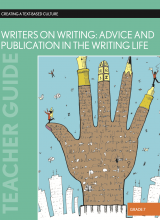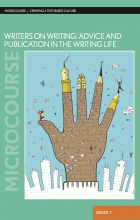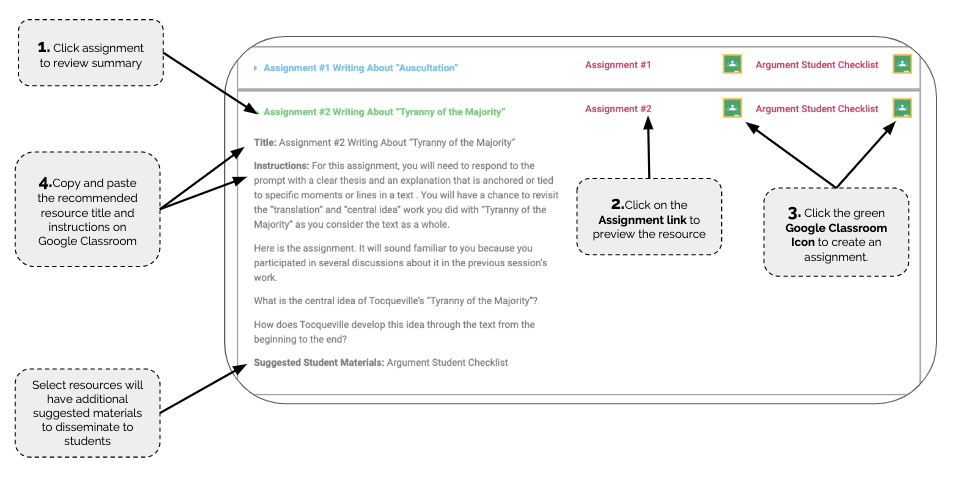Writers on Writing:
Advice and Publication in the
Writing Life - Grade 7
Writing Life - Grade 7
The purpose of this study is to help teachers develop the necessary rituals and routines that will help students move further down the road toward becoming self-motivated, proficient writers. Just as we cannot become runners without running a lot, we cannot become writers without writing on a regular basis.


Table of Contents
Writing Tasks
Title: Writing Project Proposal
Teacher Manual Instructions:
Session 9
Place on the board a series of deadlines for their writing project:
Writing Project Proposal — Give students at least a week to prepare their proposals. This will ensure that students have time to review notebook entries and to make thoughtful and informed decisions about how they want to spend their time and energies. While students should be permitted to revise this proposal after the established date, a firm deadline will help minimize procrastination.
First draft deadline.
Second draft deadline.
Publication submission deadline — Each semester, each student should submit at least one of his or her independent writing project pieces for publication. Given what we know about the nature of revision and the work of writing, teachers are strongly encouraged to set the deadline for this submission at the end of the semester. In this way, at the end of each semester, all students will have a single deadline for their revised, publication-ready piece.
Display the “Writing Project Proposal” for the class to see and distribute a paper copy to each student. (See Appendix for a copy-ready version.)
Review each section of the form with the class.
Answer any questions students have about the “Writing Project Proposal” contents.
Give students 7-10 minutes to think and write about project ideas they are considering.
If possible, allow students to access computers to consult sites from the “Online Writing Resources” and the “Getting Published” resource list.
Suggested Student Materials: Online Writing Resources, Getting Published (See Unit Resources below)
Title: Setting Goals for Independent Writing
Teacher Manual Instructions:
Session 11
Display “Setting Goals for Independent Writing” for the class to see and distribute a copy to each student. (See next page or Appendix for a copy- ready version.)
Review the contents of the goals sheet with the class. Answer any questions students have.
Give students time to complete the “Setting Goals for Independent Writing” worksheet.
Charts for Discussion
Title: Topics from last year I might want to read or write more about this year
Teacher Manual Instructions:
Session 1
Ask students to think back to their writer’s notebook work last year. Give them 2-3 minutes to generate independently a list of the things (topics) they wrote about during last year’s work.
Reconvene the class and give students time to share their lists. Work to capture the class’ thinking on a list titled “Topics from last year I might want to write more about this year.” Ask students to create a version of this list in their notebook.
Title: The Number of Genres in Which We Have Written
Teacher Manual Instructions:
Session 2
Ask students to take 2-3 minutes to think about and make a list of the genres they have had practice writing in. (If students have access to last year’s literacy notebook, they can use their old notebook to help make their lists.)
In a whip-around fashion, ask each student in the class to share the different genres they have written in. Capture these in a list on the board.
Next, ask each student to count up the number of different genres he or she has written in.
Work with the class to create a new chart titled “The Number of Genres in Which We Have Written.” This might take the form of a bar graph with numbers ranging from one to seven. The purpose of the graph is to help students mark the number of genres they explored in past years and to suggest the number of new writing avenues that lie ahead. Having this discussion in this way builds community, and promotes positive peer pressure.
Title: King’s advice and big ideas list
Teacher Manual Instructions:
Session 4
After the reading, place students in groups of twos or threes and give them 3-5 minutes to identify at least two key moments in King’s text. A key moment might be a place in the text where she says something that seems helpful. It might also be a moment that seems important but that students need to think more about.
Next, reconvene the class and ask students to share the moments they marked. As the class discusses each of these moments, work with students to create on the board a list of the advice or big ideas King provides. Ask students to create a copy of this list in their own literacy notebook. Work hard to ensure that the items on the list are very specific.
Title: Wooldridge’s advice and big ideas list
Teacher Manual Instructions:
Session 5
After the reading, place students in groups of twos or threes and give them 3-5 minutes to identify at least two key moments in Wooldridge’s text.
Next, reconvene the class and ask students to share the moments they marked. As the group discusses each of these moments, work with them to create on the board a list of the advice or big ideas Wooldridge provides. Ask students to create a copy of this list in their own writer’s notebook.
Title: Ralph Fletcher’s Advice for Crafting Your Story
Teacher Manual Instructions:
Session 6
Give students time to read, independently, “Crafting Your Story” by Ralph Fletcher. This shift from read-aloud to independent reading is designed to help prepare them for the mining of writing resource advice ahead.
Tell students that as they read, they should mark key moments in the text that they can share with the class later.
Give students time to read the selection.
After the reading, ask the class: What is this chapter about? What are the key moments and important ideas? Take time to discuss these questions as a whole group. Take care to insist that students refer to specific moments or lines in the text during the discussion.
At the end of the discussion, ask students, “What advice or examples did Fletcher make that you could use in your own writing?” Capture students’ responses to this question on a chart titled “Ralph Fletcher’s Advice for Crafting Your Story.”
Title: Ralph Fletcher’s Advice for Crafting Your Story
Teacher Manual Instructions:
Session 10
Create the “Rubric for Scoring the Literacy Notebook” on a chart or another display. In his book Time for Meaning, Randy Bomer recommends that teachers use the following three criteria to evaluate literacy notebooks: volume, variety, and thoughtfulness.
Consider adding to these a fourth criterion: writing resource advice.
Review the rubric with the class. Explain that when you look at a notebook to score it, you will be looking for four things: volume (How many entries?); variety (How many different kinds of entries?); evidence of thoughtfulness (Is this student taking this seriously? Is there evidence of thinking happen- ing when they write? Are they sharing with peers and getting feedback?); and a student’s use of writing resource texts.
Ask students to look at the chart and think for a minute about how many (volume) entries a student should make per week to receive a “4” for volume.
Write that number in the box and work through the rest of the rubric with the class. When you get to “evidence of thoughtfulness,” your descriptors will shift from quantitative (numbers) to qualitative (words like “very” and “some”). While this row is admittedly a bit more “fuzzy’ than the other two, its power is found in its presence—that is, students know that you are looking for thoughtfulness, so they will learn to consider it in their notebook work.
For the “writing resource advice” criterion, include descriptors that check for authentic engagement with writing resource texts, as well as students’ attempts at incorporating some of the advice they read.
Ask students to make a copy of the rubric in their notebooks or have copies of the class rubric available during the next session for students to insert in their notebooks.
Title: The Independent Writing Life
Teacher Manual Instructions:
Session 11
-
Create a chart titled “The Independent Writing Life.” Beneath that heading list the following things:
-
Looking for topics that interest me.
-
Looking for audiences and occasions I can write for. Using my literacy notebook regularly.
-
Working on and completing my writing project.
-
Choosing independent reading books that help me learn about a topic or think better about writing in a certain genre.
-
Meeting deadlines.
-
Submitting my writing project for publication.
-
-
Ask students what questions they have about the independent writing work. Answer their questions.
Checks for Understanding
Title: Ways to Begin Writing in a Particular Genre
Teacher Manual Instructions:
Session 2
Tell students that a large part of living a writing life is learning the process of writing that works for each of them as individuals.
Ask students to think for a minute about the work they did during the writing period:
Did they free write?
Did they plan what to write?
If they planned, how did they do it?
Did anyone draw or sketch?
What did they draw? Why?
Did anyone consult an example of writing in their genre, before beginning their writing? Did you find an example of writing in that genre? If you didn’t feel like you needed an example, why?
What background information did you draw on during your work?
Give the class a minute or two of complete silence to reflect on these questions and to think about their process.
Ask students to share about the process they used. Be sure to probe for de- tails by asking additional, open-ended follow-up questions. Capture useful comments on a chart titled “Ways to Begin Writing in a Particular Genre.”
Title: What We Know About Writing
Teacher Manual Instructions:
Session 8
-
Ask students, “What did you learn about writing today?” Capture their ideas on a chart titled “What We Know About Writing.” Have students create this same chart in their literacy notebook. Some examples might include:
-
It’s hard.
-
Get feedback.
-
Seek advice from other writers.
-
Sharing is helpful.
-
-
Ask for a volunteer willing to share an incomplete writing piece to be used for the next session.
Title: Writing Project Ideas
Teacher Manual Instructions:
Session 10
Once again, invite volunteers to share ideas for the first writing project. Capture these on a chart titled “Writing Project Ideas.” This chart can be an important resource for students having a hard time coming up with ideas.
Ask students to share, “What did you learn about writing today?”
Add their ideas to the “What We Know About Writing” chart created in Session 8.
Have students add any new items to the copy of this chart in their notebooks.
Independent Reading
Title: Book Interview
Instructions:
Display a copy of the “Book Interview” for the class to see and distribute paper copies to students. (See example nearby or the Appendix for a copy-ready version.)
Using the book you just interviewed, show students how to fill out the sheet.
Pass out three books to each student.
Give students time to make an entry on their “Book Interview” sheet for each of the three titles.
Title: Books I’d Like to Read
Teacher Manual Instructions:
Organize students’ desks into one large circle, or two or three smaller circles.
Ask students to get out their notebooks.
Explain that the writer’s notebook will play an important role in their reading work and that writers often use their notebook to reflect on and track elements of their reading life as well.
Ask students to turn to the next blank page in their notebook.
Ask students to place the following heading at the top of that page: “Books I’d Like to Read.” Remind them to add this entry to the table of contents as well. Model this using your own notebook. Use the example above as a guide.
Explain that this page is the place where you write down books that you want to be sure to read. In short, it’s a remembering tool or a decision-making tool.
“Book Interview” forms students completed during the last session back to the class. Give students a moment to review these and, if they interviewed a book they think they might like to read, to enter it on the list.
Title: Book Pass
Teacher Manual Instructions:
• Explain the purpose of a book pass:
» A book pass is another way to expose students to the texts available to them in the classroom library. A book pass requires students to use their book interviewing skills. A book pass is a chance for students to find titles to add to their “Books I’d Like to Read” list.
Distribute copies of the “Book Pass” sheet to students. (A copy-ready version can be found in the Appendix.)
Be sure you have one title for each student in the circle.
Give each student one book (or magazine). Tell students it doesn’t matter what they start with, because they will see all the books.
Choose a direction for passing.
After students receive a book, they should immediately record the author’s name (if the text is a book) and title on the “Book Pass” sheet.
Give students one minute to interview each book following the procedure established in the previous session.
At the end of one minute, call “pass.” At this time, students should make an entry in the comments column and pass the book to the next student.
Continue the book pass until each student has interviewed all the books.
Title: Goals for My Reading Life
Teacher Manual Instructions:
Ask students to turn to the “Books I’d Like to Read” page in their notebooks.
Display a copy of “Goals for My Reading Life” for the class to see and distribute copies to students. Using the display copy, show students how to fill out the goals sheet. Show them how they can use the information charts created in earlier sessions to generate ideas for answers to the “Goals” questions.
Explain that at the beginning of each six weeks, each student will fill out
a new goals sheet. At the end of each six weeks, students will take a few minutes to review their goals statements and reflect on their efforts to meet them.Answer any questions students have about the “Goals for My Reading Life.”
Give students time to complete the sheet. (They should only fill out the goal-setting portion of the assessment at this point.) Tell them that these will be collected at the end of the closing meeting and that you will return these at the next session. (You may decide to photocopy a set for yourself.)
Return the sheets to students during the next session and have them attach the sheet to a page in their notebook.
Title: Reading Log
Teacher Manual Instructions:
Write “Reading Log” on the board.
Explain to the class that a reading log is simply a place where a reader keeps track of all the reading he or she has done over a period of time.
Ask students to turn to the next blank page in their notebooks and to reserve at least three pages for the reading log.
On a piece of chart paper or another display, show students how to set up a “Reading Log” in their writer’s notebook. (See example on next page.) They should be sure to enter it in their table of contents as well. You may decide to distribute sticky notes so that students can flag this page.
Explain to students that they should make an entry in their log only after they have finished a book. You will need to negotiate with students how to handle the entry of magazine readings (for example, entire issues versus individual articles).
After students have set up the log, including proper headings, creating the grid, etc., show students how to make an entry.
Answer any questions students have about the reading log.
Tell students that they can make their first entry in their reading log at the beginning of independent reading.
